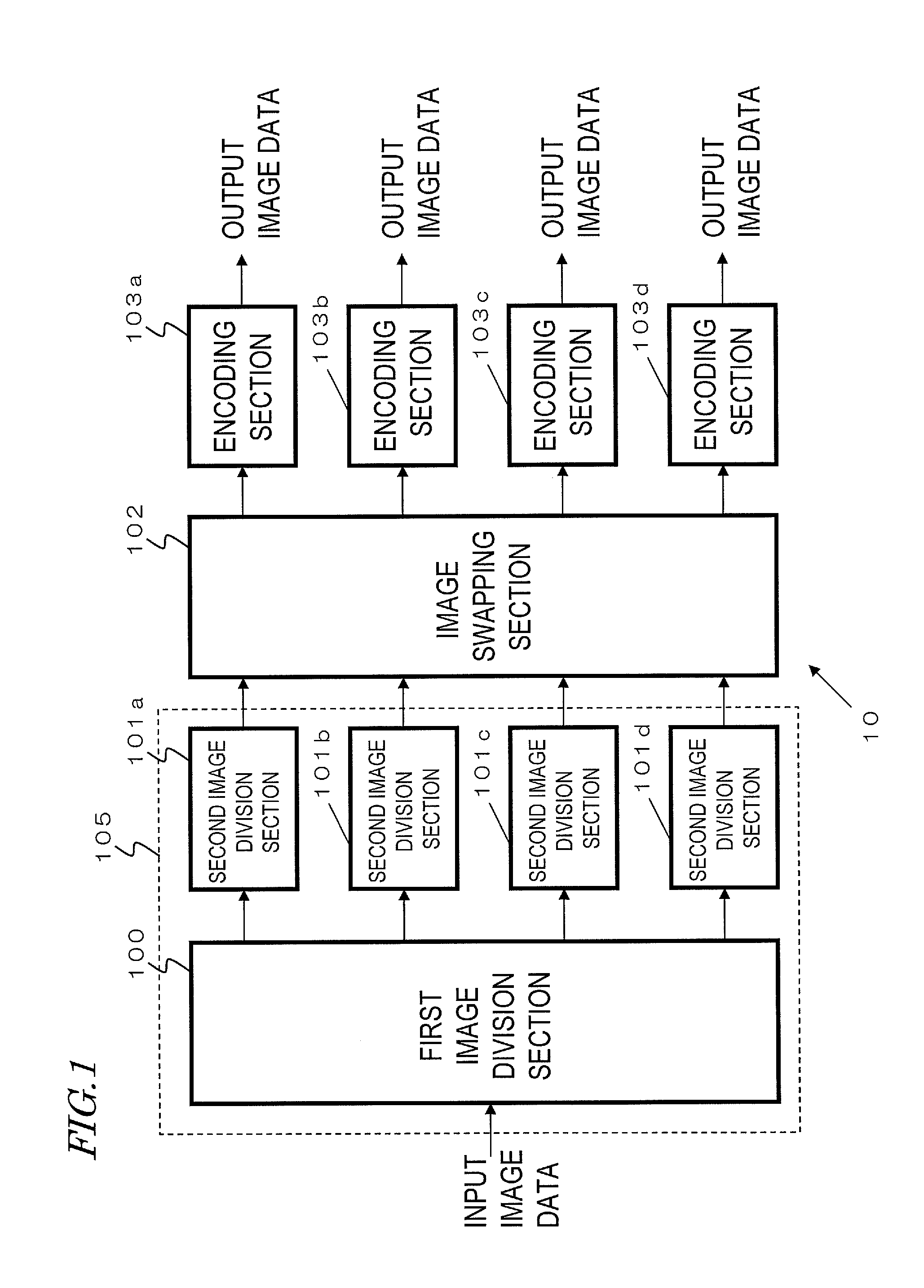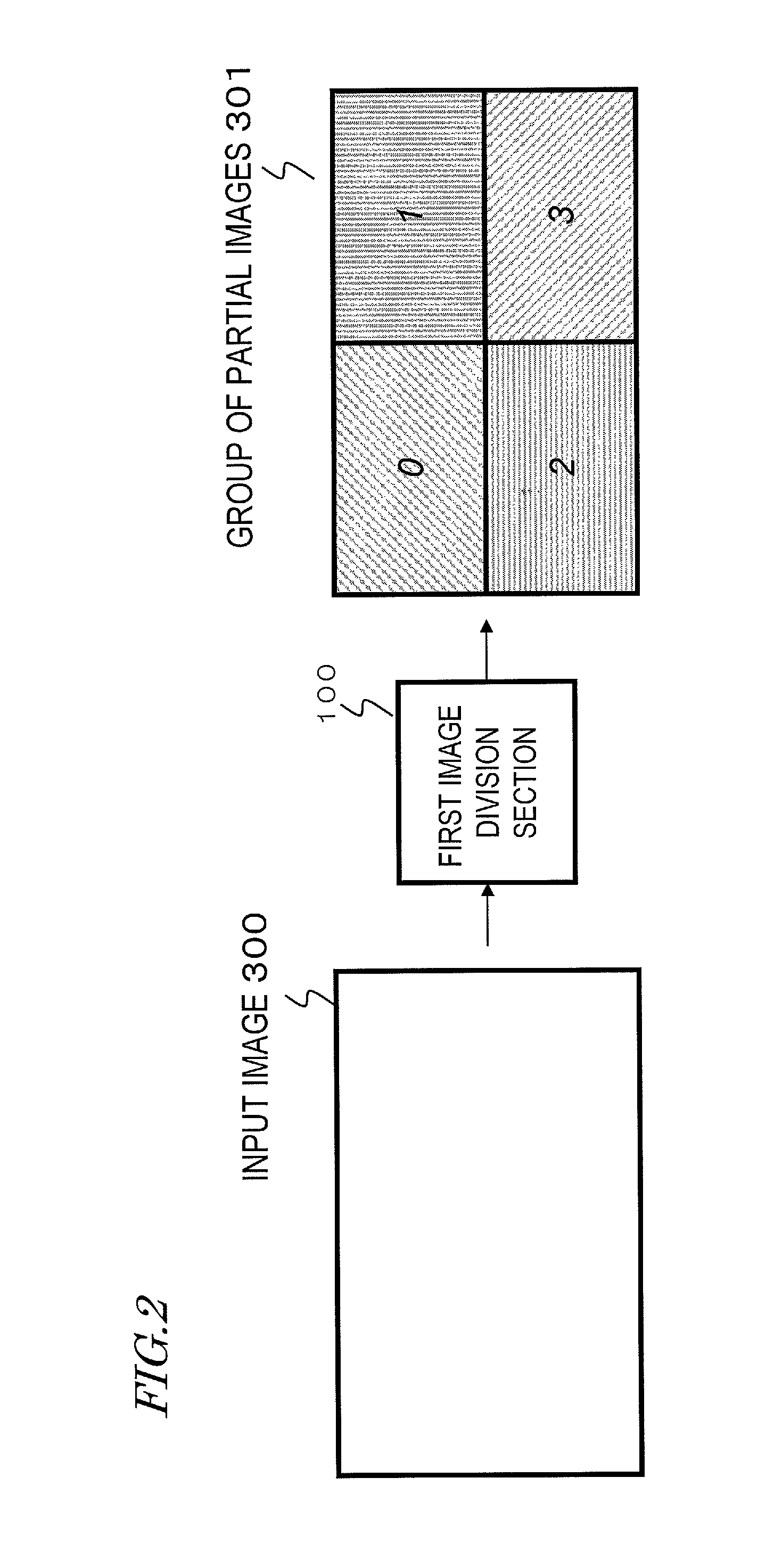Image encoding device and image decoding device
a technology of image encoding and decoding device, which is applied in the direction of instruments, electrical appliances, computing, etc., can solve the problems of reducing the inter-frame compression efficiency, reducing the compression efficiency, and increasing the process delay, so as to prevent the compression efficiency from lowering, improve the uneven distribution of graphic patterns, and level the compression difficulty
- Summary
- Abstract
- Description
- Claims
- Application Information
AI Technical Summary
Benefits of technology
Problems solved by technology
Method used
Image
Examples
embodiment 1
1-1. Configuration of Image Encoding Device
[0049]FIG. 1 is a block diagram showing a configuration of an image encoding device 10 of the present embodiment. The image encoding device 10 includes a first image division section 100, second image division sections 101a to 101d, an image swapping section 102, and encoding sections 103a to 103d.
[0050]The first image division section 100 receives image data. The first image division section 100 spatially divides the received image data into image data each of an appropriate size. The data of divided images (hereinafter referred to as “partial images”) are encoded in parallel in the encoding sections 103a to 103d after subsequent processes.
[0051]FIG. 2 schematically shows the process of the first image division section 100. The first image division section 100 receives image data of an input image 300, and performs a spatial division process. A group of four partial images 301 is obtained as a result of the division process. In the presen...
embodiment 2
[0082]The second image division sections 101a to 101d of Embodiment 1 generate strip-shaped image fragments.
[0083]The second image division sections 101a to 101d of the present embodiment generate image fragments which are not strip-shaped. The discussion below will focus on the second image division sections 101a to 101d and the shape of the image fragments.
[0084]Note that the configuration of the image encoding device of the present embodiment is the same as that of the image encoding device 10 of Embodiment 1. Therefore, the image encoding device of the present embodiment will be described assuming that it is the “image encoding device 10” shown in FIG. 1.
[0085]Parts of the configuration and the operation of Embodiment 2 that are different from those of Embodiment 1 will be described below. Components and the operation thereof which are not mentioned below are the same as those of Embodiment 1.
[0086]FIG. 7 shows a division scheme for dividing partial images into pieces by the sec...
embodiment 3
[0098]The present embodiment is directed to an image encoding device in which an image expansion section is added to the configuration of the image encoding device 10 of Embodiment 1 or 2.
[0099]FIG. 11 shows a configuration of an image encoding device 20 of the present embodiment. In FIG. 11, like components of the image encoding device 20 to those of the image encoding device 10 of Embodiment 1 in terms of function are denoted by like reference numerals and will not be described below.
[0100]An image expansion section 900 has a function of expanding the size of the image of the input image data. The image size is expanded for the purpose of adjusting the size of the image of the input image data so as to obtain partial images of a size that can be processed by the encoding sections 103a to 103d. Where the size of the input image is not an integral multiple of an image size that can be processed by the encoding sections 103a to 103d, it is not possible, as it is, to obtain partial im...
PUM
 Login to View More
Login to View More Abstract
Description
Claims
Application Information
 Login to View More
Login to View More - R&D
- Intellectual Property
- Life Sciences
- Materials
- Tech Scout
- Unparalleled Data Quality
- Higher Quality Content
- 60% Fewer Hallucinations
Browse by: Latest US Patents, China's latest patents, Technical Efficacy Thesaurus, Application Domain, Technology Topic, Popular Technical Reports.
© 2025 PatSnap. All rights reserved.Legal|Privacy policy|Modern Slavery Act Transparency Statement|Sitemap|About US| Contact US: help@patsnap.com



